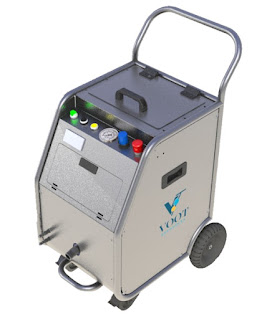From Traditional to High-Tech: The Evolution of Cleaning Methods with Dry Ice Blasting Machines
Cleaning is fundamental to maintaining cleanliness and safety in various industries, from manufacturing to food processing. Over the years, traditional cleaning methods have evolved into more efficient and environmentally friendly alternatives. One such innovation is the dry ice blasting machine. In this blog post, we will explore the evolution of cleaning methods and the significant role of dry ice blasting machines in modern cleaning processes.
The Traditional Cleaning Dilemma
In the past, industries relied heavily on
labor-intensive cleaning methods that often involved harsh chemicals, abrasive
materials, and significant downtime. These methods not only posed a risk to
worker safety but also contributed to environmental pollution. The need for a
more effective, sustainable, and safer cleaning solution prompted the
development of dry ice-blasting machines.
The Birth of Dry Ice Blasting Machines
Dry ice blasting, also known as CO2 blasting,
uses solid carbon dioxide (dry ice) pellets as the cleaning agent. It's an
innovative cleaning method that was first introduced in the 1980s. Dry ice
pellets are accelerated through a high-velocity nozzle, transforming into a
stream of tiny, high-speed pellets that impact and remove contaminants from
various surfaces.
The Advantages of Dry Ice Blasting Machines
1.
Environmentally Friendly: Dry ice blasting is an
eco-friendly cleaning method because it doesn't involve the use of chemicals or
leave behind harmful residue. Dry ice pellets sublimate into carbon dioxide
gas, which is already present in the atmosphere, making it a sustainable
choice.
2.
Non-Abrasive: Unlike abrasive methods such as
sandblasting, dry ice blasting is non-abrasive. It effectively removes
contaminants without damaging the underlying surfaces, extending equipment life
and reducing the need for costly repairs or replacements.
3.
Reduced Downtime: Traditional cleaning methods often
require time-consuming disassembly of machinery or equipment. Dry ice blasting
can be performed on-site, reducing downtime and minimizing production
disruptions.
4.
Safe and Health-Conscious: Dry ice blasting eliminates
exposure to harmful chemicals and reduces worker safety risks associated with
other cleaning methods. It is a non-conductive process, making it safe for use
on electrical equipment.
5.
Versatile: Dry ice blasting machines can clean a wide
range of surfaces, including industrial machinery, electrical components,
automotive parts, and even historical artifacts, making them incredibly
versatile in various industries.
Applications of Dry Ice Blasting Machines
Dry ice blasting machines have found applications
in numerous industries, including:
1.
Food and Beverage: Ideal for cleaning production
equipment, conveyor belts, and ovens in food processing facilities without the
risk of contamination.
2.
Manufacturing: Used to clean molds, tooling, and
machinery in automotive, aerospace, and plastics manufacturing.
3.
Restoration: Effective for removing paint, grime, and
contaminants from historical structures and artifacts without causing damage.
4.
Electronics: Safe for cleaning delicate electrical
components, circuit boards, and industrial electronics.
5.
Fire Remediation: Used to remove soot and smoke damage
after fires without further damaging surfaces.
Conclusion
The evolution of cleaning methods from
traditional, labor-intensive techniques to high-tech solutions like dry ice
blasting machines marks a significant step forward in efficiency,
sustainability, and safety. As industries increasingly prioritize environmental
responsibility and worker safety, dry ice blasting machines have emerged as a
versatile and eco-friendly cleaning option. With their ability to remove
contaminants effectively without harming surfaces, these machines are changing
the way industries approach cleaning and maintenance.
FAQ
What is dry ice blasting, and how
does it work?
Dry ice blasting is an innovative
cleaning method that uses solid carbon dioxide (dry ice) pellets as the
cleaning agent. It works by accelerating dry ice pellets through a
high-velocity nozzle. Upon impact, the dry ice pellets transform into a stream
of tiny, high-speed pellets that effectively remove contaminants from various
surfaces. The process is non-abrasive, environmentally friendly, and leaves no
harmful residue.
What are the advantages of using
Dry Ice Blasting Machines over traditional cleaning methods?
Dry ice blasting machines offer
several advantages over traditional cleaning methods. These include being
environmentally friendly since no chemicals are involved, non-abrasive to
surfaces, reduced downtime as equipment can be cleaned on-site, enhanced worker
safety due to the absence of harmful chemicals, and versatility in cleaning
various surfaces across different industries. Moreover, dry ice blasting
extends the life of equipment and reduces the need for costly repairs or
replacements.
In which industries can Dry Ice
Blasting Machines be used, and what are some common applications?
Dry ice blasting machines have
versatile applications across multiple industries. Some common industries that
benefit from these machines include food and beverage, manufacturing
(automotive, aerospace, plastics), restoration (historical artifacts,
structures), electronics (circuit boards, electrical components), and fire
remediation (soot and smoke damage removal). The non-abrasive and eco-friendly
nature of dry ice blasting makes it suitable for a wide range of cleaning and
maintenance tasks in these sectors.
Call Us: 8879944460
Email Us: info@vootclean.com
For More Details Visit: https://vootclean.com/


Comments
Post a Comment